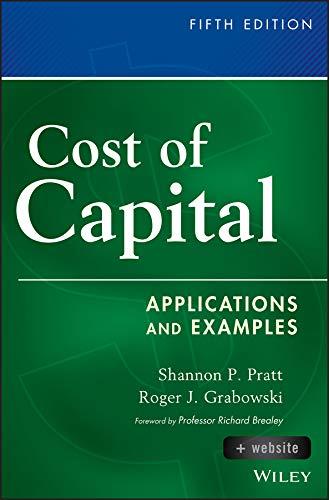Question
1.You are evaluating a project which has a useful life of 5 years. However, you suspect that the projects economic life might be different. The
1.You are evaluating a project which has a useful life of 5 years. However, you suspect that the projects economic life might be different. The initial investment for the project is $5,000,000. The cash flows for the 5 years are $1.5 million, $1.7 million, $1.8 million, $2 million, and $2 million. The abandonment value of the project in each of the first 4 years is $4.2 million, $4 million, $3.5 million, and $2 million. The abandonment value for the 5th year is incorporated into the cash flow given above. The required rate for this project is 15%. a. What is the NPV of the project, assuming its useful life? b. Determine the economic life for the asset. c. What is the meaning of the result in b?
2.You are evaluating two mutually exclusive projects. The cash flows for each are: Project A Project B Year 0 ($60,000) ($85,000) Year 1 $20,000 $22,000 Year 2 $35,000 $25,000 Year 3 $20,000 $30,000 Year 4 $25,000 $25,000 Year 5 $15,000 Year 6 $10,000 Year 7 $10,000 Year 8 $10,000
Assume that, if needed, each project is repeatable with no change in cash flows. Your cost of capital is 13%. a. Using the replacement chain approach, which project would you chose to invest in? b. Using the equivalent annual annuity approach, which project would you chose to invest in?
3.You are evaluating a project for your company. The initial outlay for the project is $5,000,000, and free cash flows for the project are $1,000,000, $3,000,000, $3,000,000, $4,000,000 and $4,000,000. For risk analysis, you utilize the Payback and Discounted Payback methods to trigger increased risk scrutiny. Your standard is, any project that goes longer than 3 years under either metric will go through these increased risk tests. If your required rate is 12%, does this project qualify for increased scrutiny? Any problems with this approach?
4.Two mutually exclusive projects have the following forecasted cash flows:
Year A B 0 -20,000 -20,000 1 10,000 0 2 10,000 0 3 10,000 0 4 10,000 60,000
a. Compute the internal rate of return for each project. b. Compute the NPV for each project if the required rate is 10%. c. Which project should be accepted, and why? 5. A project has an initial outlay of $25,000,000 in year 0, and an additional $15,000,000 in year 1. Free cash flows will then be $4,500,000 per year for 10 years. a. What is the Payback for the project? b. Calculate the NPV, IRR, MIRR and PI for the project, if your required rate is 12%. 6. Describe how the Fisher Effect explains the interaction of expected inflation and changes in interest rates.
Step by Step Solution
There are 3 Steps involved in it
Step: 1

Get Instant Access to Expert-Tailored Solutions
See step-by-step solutions with expert insights and AI powered tools for academic success
Step: 2

Step: 3

Ace Your Homework with AI
Get the answers you need in no time with our AI-driven, step-by-step assistance
Get Started


